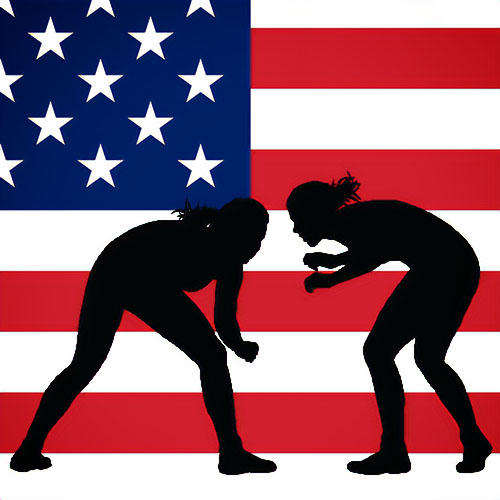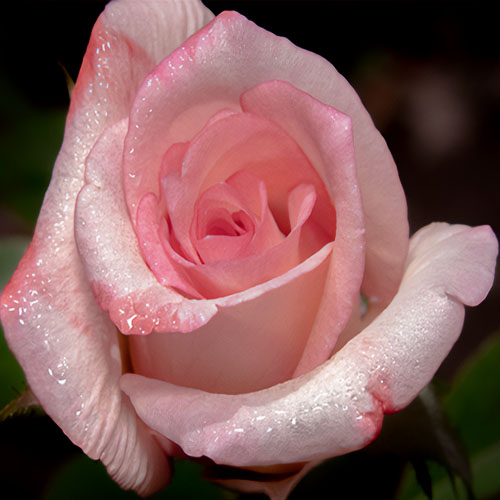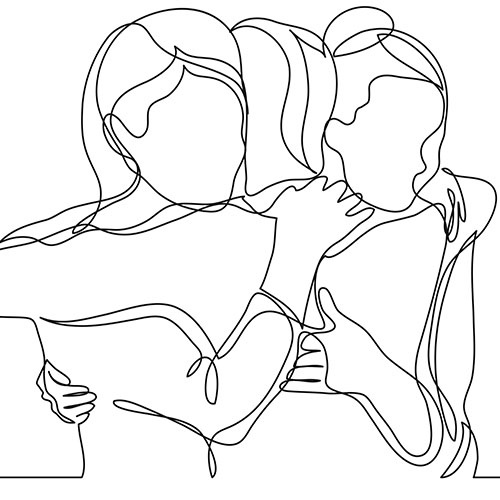Sex is too important to surrender to radical feminists who spit their anti-man, anti-porn venom in the faces of women who enjoy both.
Women Tell Us “Why I Love Porn”
As a healthy woman and a self-respecting feminist, I know. Pornography has been a positive force in my life. But since my “Advise & Dissent” piece “Banning Pornography Endangers Women” ran in the December 2002 Penthouse, it has been suggested that I am atypical and unrepresentative of women.
I lack the arrogance to claim that I speak for all women, that’s true. But my basic response to porn is a common one shared by many women — indeed, by most of the women I’ve spoken with about pornography. These are competent, intelligent, self-respecting females who enjoy depictions of graphic sex. If they become offended, they possess enough free will to close the magazine or click off the video.
But society can’t handle women who enjoy pornography. We have to be sluts or immoral, to be acting out past abuse or be in thrall to a porn-loving man; we must apologize and be ashamed. Then our enjoyment of graphic sex makes sense to society, and we are forgiven. No wonder so many normal women — neighbors and coworkers — will never admit to having opened a “men’s magazine.” No wonder so many women I’ve interviewed, including some in this article, begin talking with enthusiasm and end with the request “Don’t use my full name.” It is a request I always honor, because no one should pay a price for getting harmless pleasure from words and images.
I openly defend pornography, first and foremost from the truth of my own experience. Without porn, my adolescence would have been a wasteland of misinformation about sex, and worse. My mother killed any childhood curiosity by describing the sex act as “the man pees inside of you.” Only by raiding my brother’s sock drawer, with its hidden cache of men’s magazines, did I glimpse women who enjoyed sex, wanted sex, and were shameless about it. When my brother discovered the trespass, we had the only sane conversation about sex that I remember from childhood. In the end, he made me solemnly promise not to look at the one magazine showing real penetration. Next time, it was the first magazine I opened.
I discovered pornography in time to validate the healthy sexual stirrings of adolescence. Years later, when it was the right time for me, I was able to enjoy sex, to want sex, and — mostly — to do it shamelessly, even with my mother’s voice still ringing in my ear.
This theme kept cropping up in interviews I conducted with women for this article: Pornography gave them an early window into sexuality that otherwise would have remained slammed shut by family life. Avedon Carol, head of Feminists Against Censorship, describes the dearth of knowledge passed on by her parents: “My mother told me not to touch myself ‘down there’…. When I was 12 my father one day blurted out, ‘You know, boys don’t just want to hold hands.’ I don’t know what inspired it, and there was no follow-up.”
For other women, pornography not only bridged ignorance but also helped to heal bad sexual experiences. Beth S. writes, “I am a survivor of sexual assault. I was quite young when I was assaulted, though fortunately I was not raped. My exposure to pornography, both preteen and as a teenager, helped me see sex as something other than this evil thing that had infiltrated my life in a truly negative way at an early age. Being ‘one of the guys’ and being in on the jokes helped me laugh at sex and not fear it.”
It took me a long time to become comfortable with my own sexuality, and anti-porn feminists made that journey far more difficult than it had to be. If I enjoyed graphic sexual images, they said I hated women. When I said a girlfriend who stripped showed “panache,” they reviled me for applauding the oppression of women.
All this despite the fact that my sexual preferences are smack in the middle of the bell curve. I can only imagine the hell such feminists inflict on women who are slightly off the curve, like my friend whose exhibitionism made her love peeling off clothes at a bar on weekends. I once interviewed Crystal Wilder, a porn actress and exotic dancer, who said, “[Men] think I am an ultimate fantasy. Some call me a superstar and come into the clubs for no other reason than to see me. It is the greatest feeling in the world.” Crystal paid a high price for that feeling: She became a safe and convenient target of disdain for anti-sex feminists.
Women who consume pornography don’t fare a great deal better. Lisa W. says, “It seems more women enjoy pornography than you’d think, but because of social acceptability, they choose not to share the fact that they enjoy it.”
“Sex is a feast, and most poor bastards are starving to death.”Auntie Mame
I don’t know a single person who hasn’t willingly viewed pornography at some time, and I know many women who enjoy it regularly. I also know women who feel harmed by pornography, which is an extremely good reason for them to never consume it again, just as women who have been harmed by marriage should be cautious about saying “I do” in the future. Women have to judge for themselves what is sexually liberating, boring, or offensive. And the best way to know what those judgments are is to ask the women … and then to take what they say seriously.
That is feminism.
And feminism has entered a new century. Feminism must now deal with Gen X powerhouses like Janis Cortese, who describes herself as “an erotica-writing, handgun-owning, bisexual dominant woman with an M.S. in physics.” She warns anti-sex feminists, “Your all-out opposition to such things as BDSM [Bondage/Domination/Submission/Masochism] and the sex industry is a huge mistake” — a mistake she means to correct. “I am publishing and writing erotica — and simultaneously demolishing the hideous belief in this country that porn is only and ever composed of nekkid chicks. I am not a sellout — I am a revolutionary.”
Let the revolution begin! And let true diversity reign. To paraphrase Auntie Mame, “Sex is a feast, and most poor bastards are starving to death.”
To begin at the beginning… How do women discover pornography? There are as many stories as there are women, but Jen Loy’s seems typical. Loy, the editor in chief of Kitchen Sink magazine, says that when she was nine or ten she was biking with friends outside a small town in Southern California when one of them revealed a stash of “dirty” magazines. Loy writes, “I don’t remember what we saw that day, but I do remember the rush I got from looking at the torn, muddy, stained pages — not to mention the constant looking over my shoulder, wondering if any adults back in the housing development knew what we were up to…. I knew what we were doing was considered bad and that we had a really cool secret.”
Even if the pornography was not “forbidden,” this didn’t seem to dampen the excitement of the first view of it.
Teresa C. writes, “My first experience with porn happened when I was about six or seven. A neighbor boy got hold of his dad’s girlie magazines and shared them with me and another girl. We didn’t play doctor or anything, we just looked at the pictures.” This innocent experience turned traumatic for her friends owing to the overreaction of their parents. Her friends were “punished severely for daring to look at those magazines,” but Teresa, who now publishes erotica of her own, did not get in trouble. Teresa’s grandparents, who raised her, “felt it was natural to be curious [about sex].” In fact, most nights around ten, Teresa was sent off to bed and her grandfather watched the adult-movie channel on cable. She says, “My grandfather was a God-fearing man who attended church every Sunday but disagreed with the church on porn. He said watching sex was a lot better than watching people getting murdered. My grandmother sometimes watched them with him.”
Stephanie S.’s cousin showed her “his father’s porn collection in [the] attic.” She chuckles about this now because her aunt was “a church-going, PTA-crusading, Little-League loudmouth mom” who was “always comfortable with her husband’s overflowing porn collection.” Stephanie’s reaction to the erotica? “Most of the images struck my curiosity and excited me. But I was frightened because I was shown an image of a woman’s vagina wrapped in chains.” Stephanie and her sister were inspired to read books “disguised as sexual-health paperbacks,” then doled out information to their entire high school; their specialty was advice on anal sex. Today, Stephanie rarely consumes porn (with the exception of any video featuring Rocco Siffredi).
Jen M. used porn somewhat differently at school. She rented out copies of books on sex to her classmates at a dollar a day. Jen thought the sex depicted in them was “something kind of silly that no one I knew would ever do.” Nevertheless, “finding pornography, seeing that people seemed to enjoy it and see it as normal, really made me feel better about sex.”
Some of the women I interviewed didn’t experience porn until well past adolescence. “Wren,” a thirtysomething career woman and mother of one, describes herself as “college educated, moderately conservative, and somewhat religious.” Her earliest exposure to porn consisted of occasionally flipping through Playgirl in college. After divorcing, she explored “some sexual things” on the Internet and found herself at “a Website billed as ‘erotica for women.’” Wren experimented. Some sites were “a complete turn-off,” but she particularly liked a story site at which she could choose three levels of explicitness. She followed a link to a message board where she “discovered a discussion topic I had always fantasized about but never explored in real life.” To Wren, the most amazing aspect of e-chatting was meeting “many women online from all walks of life…. I heard the same story over and over, women who said they always wanted to explore their sexual thoughts and feelings in a safe place.” Now that she has reunited with her husband, she is shy about telling him about her sexual self-exploration.
A safe place. This is an invaluable aspect of pornography: It lets women satisfy their curiosity safely. Porn offers a panoramic view of sexual possibility: masturbation, voyeurism, exhibitionism, sex with a stranger, in a group, with the same sex… Like adventure movies that take you to lands you may never visit, pornography allows you to vicariously sample sexual acts of all sorts.
This doesn’t necessarily mean women want to pursue the activities they see on a screen. Most are probably like me — I have no desire to sleep with anyone but my husband. I want to share decades of new experiences with the same man by keeping everything — from the sex in our bed to the food on our table — balanced between fresh, new experiences and familiar, comfortable ones. Pornography helps the balancing act.
It also helps you discover what you definitely don’t want to pursue, married or not. Porn lets you know what you don’t like without having to go through a real-world experience to find out. Negative reactions offer you valuable information. One of the reasons Sallie Tisdale’s pivotal book Talk Dirty to Me: An Intimate Philosophy of Sex stirred up a maelstrom in the nineties is because she was candid about all her reactions to graphic sex. Some pornography thrilled her, some of it revolted her, and some elicited both responses; she was real about sex and pornography.
Tisdale wrote Talk Dirty because no one was approaching sex viscerally. She explains, “Women have spoken very little about sex in terms of desire rather than in terms of romance or love or security. We’re in a fairly new cultural state…. But for Western women, our inheritance has been that we don’t talk about sex in terms of desire.”
It wasn’t because women (and men) didn’t want to talk. When she started writing Talk Dirty, Tisdale expected her friends to look at her askance. Instead, they telephoned and demanded, “Why haven’t you interviewed me yet? I want to talk about sex. Nobody ever lets me talk about sex.”
Opening up about sex doesn’t have to be a brutal or life-altering experience. Trudy Schuett, a fathers’ rights advocate and publisher of Desert Light Journal, describes the first sex film she ever saw: “In the early seventies, I had a regular outing on Tuesdays with my friends we called Ladies’ Night. One night, one of the ladies had what was then called a stag movie — black and white, no sound. Maybe seven minutes long. We sat and watched it. Nobody said a word for seven minutes. When it was over, one woman said, “Okay, let’s go bowling.’”
“Anti-sex feminists cannot root out pornography, because they keep stumbling over healthy women who enjoy it.”
Knowing what you don’t enjoy sexually is as important as knowing which dish you don’t want to order off a menu. Kerstin M., a young German woman, says, “I feel extremely uncomfortable with bondage and S/M-related practices. I don’t care much about back-door action either.” (Meanwhile, Avedon Carol likes S/M because “it gets me hot.”) In rejecting S/M, however, Kerstin doesn’t close off the pornography that appeals to her tastes.
Kerstin’s introduction to porn came on her 16th birthday when a friend gave her the book Fanny Hill. “I was delighted,” Kerstin remembers. She went on to revel in another classic, The English Governess, about a governess who must educate a teenage boy who is caught masturbating by his father (what a crime!). She whips and spanks him and turns him into an obedient sex slave who worships at her feet. Kerstin says she laughed heartily because “the author described it with a twinkle in his eye” and she couldn’t take the “atrocious actions” seriously. At some level, Kerstin clearly finds S/M appealing.
A woman’s porn preference involves not only the type of sexual act but also how the act is presented. What is the ideal presentation? Kerstin’s would be “a pornographic version of The Piano by Jane Campion, with all the dirty details in it, graphic and explicit.”
As titillating as pornography can be, it serves a largely unacknowledged purpose: It is sexual how-to literature. Girls and women often lack the most basic information, such as what their own sex organs look like. Boys have blatant erections and an almost built-in sense of how to orgasm, but nothing about orgasm is intuitive to girls. Jen M.’s experience is typical: “After I discovered The Joy of Sex, I soon discovered the joy of masturbation. As a young teen, I could never masturbate by myself. I always needed something to look at. I still consume pornography. It’s easier with your own credit card.” Looking back on her girlhood experiences, Jen says, “Pornography helped me understand my own sexuality. I know that’s kind of a cliche, but it’s true. It helped me figure out what I liked and didn’t like, and things I’d like to try.”
Katrine M. had a similar experience: “I remember wondering about how women masturbated. For men it seemed easy enough; after all, their genitals were out in the open and easily manipulated. I couldn’t even see my own, and I still never have! But here, too, porn came to the rescue. Women masturbate in porn. A lot. In the books I’d read, it was already kind of hard to figure out what was actually done, but on-screen there was no chance of misinterpretation.”
Oral sex is another lesson offered by pornography. Most women hear about fellatio, the receiving of which seems to be the creme de la creme sex act for men. But where does a woman go to learn about it? If you ask a girlfriend, she’s likely to gossip and giggle behind your back. If you ask a male friend, he’ll think you are coming on to him. If you ask your mother … well, let’s not go there.
Men aren’t the only ones who have performance anxiety; women want to be good at sex too, which includes being good at fellatio. The first blowjob I ever saw was in a porn video. I vividly remember my reaction: I leaned toward the screen and said, “So that’s what you do with your hands!”
A “respectable” sex manual might describe the same process in a series of diagrams or tasteful photographs. But the video showed me how the woman teased and taunted, how she took control and clearly reveled in her dominance. It taught me the moves and attitude through visceral example.
For “Stella,” a writer for Cosmopolitan, pornography was a long journey of learning and self-exploration. At first she was repelled by it, a reaction made worse by the pornography a boyfriend brought home to share. “It was some kind of cheap fetish tape made for approximately $4.50 in, like, the Czech Republic before perestroika …. At one point this girl was hopping up and down on top of an ugly skinny dude who was wearing tube socks! And she was like, ‘Oh… oh… oh…’ and then a fly landed on her face, and without missing a beat, she blew it out of the way and then kept going, ‘Oh… oh… oh…’”
Stella could have imitated her mother, who “loves Andrea Dworkin” and “really, honestly thinks porn is evil.” Instead, Stella went on experimenting. Now she calls porn “a great shortcut to orgasm.” How does her mother feel about this? For Stella, her mother has a “right not to see porn, just as I have my right to watch porn. But man, if she took away my right, I’d be so pissed.”
Whatever brings a woman to pornography — enjoyment, curiosity, desire to learn — one thing is constant: Porn provides a safe environment. The world is a dangerous place for women who are curious. In walking out the door to look for sexual experience, they risk violence, pregnancy, disease, the stigma of being considered a slut, and all the penalties attached to adultery. In watching a video in their own bedrooms, women avoid rape, disease, divorce, and pregnancy.
Because it is “safe sex,” pornography can also heal. Because women can control the circumstances of viewing porn, it helps some women recover from sexual trauma.
I have experienced more violence than most women in our society, partly because I ran away from home at 16 and briefly lived on the streets. Pornography helped me overcome a paranoia about sex that grew from that violence. “Sneaking up” on sex in a manner I controlled allowed me to redefine my sexuality and not have to live with the definition imposed on me by abuse.
Jen M., the entrepreneur who rented sex books to schoolmates, had a similar experience. She was raped. Two months after the attack, she met a wonderful man, but couldn’t bring herself to do more than kiss. Then one night they “teased each other into getting some pay-per-view porn.” Jen writes, “It was the first time since I’d been raped that I really felt sexual desire. We sat there next to each other, no other touching than holding hands, both horny out of our minds, and then went to sleep in each other’s arms, still not touching. But the next morning we had our first sexual experience together. It’s weird, but watching that movie with him, just there next to me, knowing that he wanted me but would never try to force me to do anything, made me feel so safe.”
It is heresy — a burn-at-the-stake offense — within radical, or “gender,” feminism to suggest that pornography can ever offer anything positive to women traumatized by sexual abuse. But that’s the truth of my experience and of other women I’ve interviewed. If exactly the opposite is true for others, then they are right to shove pornography away. Jen agrees, but, unfortunately for her, the tolerance doesn’t flow both ways. She no longer bothers to discuss her experience with other women because, as she says, “they don’t respect my intelligence enough to realize that I’m not being brainwashed by the patriarchy or whatever bullshit they think.”
Historically, women have been made to feel ashamed of our sexual thoughts and desires. If we aren’t on the pedestal, we are down in the gutter — with little room to maneuver in between. If we have the courage to pursue our own sexual pleasure, we are branded as sluts, whores, nymphomaniacs. That’s what conservatives say. Radical feminists use terms like brainwashed, victim, and dupe of patriarchy. Both say the same thing: It is wrong to embrace graphic sexuality, and any woman who does so is immoral.
If the stakes weren’t so high, it would merely be ironic that such a benevolent thing as porn sparks such bitter political division. Says Norma Jean Almodovar, author of Cop to Call Girl: Why I Left the LAPD to Make an Honest Living as a Beverly Hills Prostitute and head of the International Sex Worker Foundation for Art, Culture, and Education, “If the only consequence of these gender feminists’ convoluted thinking was the expulsion of hot air from their frigid bodies during their mutual masturbation sessions, it would be bad enough, but they influence young minds — male and female alike — at the colleges and universities where they teach their distorted theories, and they influence the legislators who make the laws which directly impact the lives of millions of women who would prefer to speak for themselves.”
Women like Norma Jean are on the front lines of the fight for women’s sexuality, and they have been targeted by anti-sex feminists who claim that porn oppresses all women. After all, if such feminists took Norma Jean (or me) seriously for one second, it would mean that at least one woman in the world was not oppressed or humiliated by the graphic depiction of sex. Anti-sex feminists could no longer claim that pornography is an act of violence against all women. Norma Jean’s pleasure would become a crack in their orthodoxy. They must attack her, or admit defeat.
They have been defeated. Anti-sex feminists cannot root out pornography, because they keep stumbling over healthy women who enjoy it. The one place anti-sex feminists have succeeded is in women’s studies departments on campuses all across North America. There, pornography is analyzed as postmodern gender genocide or the social construction of patriarchy. In the rarified atmosphere of academe, pornography ceases to be words and images that some women enjoy and some women don’t; it becomes an act of rape against all women.
Perhaps this is why Stephanie experienced more sexual abuse on campus than anywhere else, including her job managing a “classy adult bookstore,” which brought her into contact with the law. Or the private porn videos she shot for a man who was a voyeur and liked to see her with another woman “rolling around naked on a bed.” Although Stephanie tends to be outspoken about controversial issues, such as sex and the right of a woman to own a gun, she writes, “The most criticism I’ve ever received was when I was in college. I created an art exhibit that incorporated sexually explicit images but conveyed a very ‘feminist’ message. The school dean censored it, despite the fact that there were nude drawings of women throughout the art school. I caught a lot of flak from uptight anti-porn women, especially crusading dykes.”
I wasn’t there, but I am sure I could repeat verbatim the anti-sex gospel hurled at Stephanie. Pornography degrades women. Pornography is rape. Pornography creates patriarchy and sexism. When an anti-sex feminist screams that dogma in my face, I react like the porn star Nina Hartley, who told me she longs to shout back, “You’re full of shit!” But she shows restraint. Usually, so do I.
Sometimes I take the same tack as Avedon Carol and try to argue reasonably — a chore similar to administering medicine to the dead. Carol argues, “If men were not sexist before porn, and porn emanates from sexism, then how could porn come into existence? If porn causes sexism, why are women in the West more powerful now since the advent of mass-produced porn than we have ever been at any time in history?”
At other times I shrug off the anti-sex arguments. Tracy Quan, a member of PONY (Prostitutes of New York) and author of Diary of a Manhattan Call Girl, gives words to my shrug when she comments, “Porn is iconoclastic and crude for the most part. These feminists are picking up on that and responding to it, but they take it to some other conclusion that makes little sense to me. They’ve built a whole social theory on an aesthetic problem.”
And in the process they have abandoned sight of the core value of real feminism: respect for the choices of women — all women.
In the nineteenth century, women battled at great personal expense to open up choice for women. They demanded a right to their own wages, to control their own bodies, and to have their contracts and consent legally recognized on an equal standing with men.
The individualist feminist Angela Heywood and her husband, Ezra, sacrificed much of their lives to ensure that women had access to birth control and the right to be full sexual beings. In an age when respectable women draped cloth over piano legs to avoid inspiring sexual thoughts, Angela — a respectable wife and mother — wrote a series of articles that shocked society with their straight-forward talk of sex. In 1883 she declared, “In the arena of Mechanics, Socket and Pivot are the law… the socket is soft, receptive iron, the pivot hard… Are not the Penis and Womb as native, handsome & worthy in use as pivot & socket?”
Angela also described the “United States Officers” who “again & again” burst into her home to “carry off the sire of my children & cage him” with criminals. Ezra Heywood was repeatedly arrested for his pamphlet Cupid’s Yokes, which advocated birth control. Under the Comstock laws, both Angela’s candid views on sex and Ezra’s advocacy of birth control were criminally prosecutable. Graphic sex and feminism were being quashed by the same political force: the repression of sexual views. Both began to flourish when the opposite social condition arose: sexual tolerance.
Modern feminists have a responsibility to carry on Angela’s fight for sexual candor and choice. The current battle over pornography is the same one Angela fought: women’s right to choose and explore their own sexuality. In this conflict, no single choice is “correct” because the delightful diversity of human nature allows for many interpretations, many tastes. As long as the choices involve only consenting adults, then our society needs every one of them. The growth of art, and culture itself, depends on the free flow of expression.
Maybe Tracy Quan is right when she adds on a comment about most porn “defiling” women. If so, the onus falls on the women who consume porn to make their preferences known by filing “customer complaints” with those who produce it. Jen M. should write to video producers and let them know that she wants more “quips” during blowjobs because they are “a very hot combination.” Stephanie should pass along her request: “I’m dying to see a video of a couple fucking in a church — not staged, real, live. The thought of that really turns me on. And as for a Catholic confessional booth, well, don’t get me started.”
I would love to get women started on complaining about porn. Not a discussion about the turpitude of graphic sex, but about the aesthetics: what they like, what they hate, what’s just plain silly. I’d love to hear women assert themselves about scripts, models, sound tracks, themes…. What fantasies have they longed to glimpse and haven’t yet? It would be a free-for-all that respected all choices — including the choice to not participate. Even more, it would be something that radical feminists have tried to systematically remove from sex for decades: fun.
Women, Sex, and Pornography are topics way too large to address in any meaningful way here. We can say that even as recently as 2004 when this article originally published there were not talking about “porn” on just regular network situation comedies. Attitudes have changed. Psychology Today ran a “volume” article last year which may or may not tell us much beyond being evidence of these changing attitudes, but it does mean the topic of women and porn has been taken up by some fairly erudite research groups. Trying to wade through the scholarly studies on the topic, though, might bore you to the point of swearing off scholarly studies — but probably not porn. Bottom line, as it were, people that like porn will continue to like it regardless of how you wish to make them feel. People that do not like it have no interest in changing their opinions. Around here, we just want everyone to be happy.
























